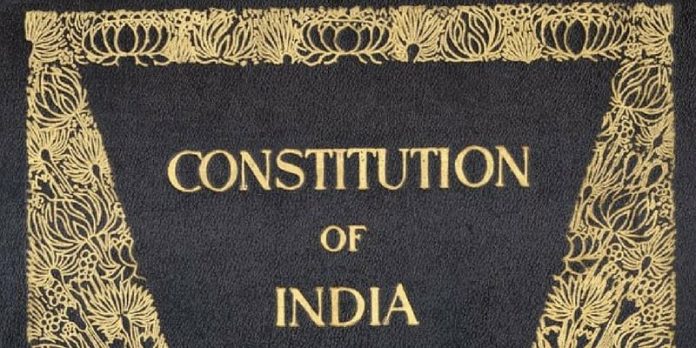This article is written by Vikrant Shinde, pursuing Certificate Course in Advanced Supreme Court Practice: Drafting, Procedure and Strategy from Lawsikho.
Table of Contents
Introduction
The Constitution of Jammu and Kashmir was made and adopted on 17 November, 1956, and came into effect on 26 January 1957. The Constitution was a legal document for recognized structure for the state government of the Indian state of Jammu and Kashmir.
Background
Jammu and Kashmir, owing to the unique geopolitical setup of India in its pre and post-independence era, was a princely state under the rule of Hindu ruler Maharaja Hari Singh, a descendant of Maharaja Gulab Singh who was the founder of the Royal Dogra Dynasty in Jammu and Kashmir. Maharaja Gulab Singh and East India Company had signed the Treaty of Amritsar which brought Jammu and Kashmir under the British paramountcy in 1846. The Indian Independence Act of 1947 had built the legal foundation for the exit of the British from the subcontinent and provided for Partition.
A Standstill Agreement was made dated 3 June 1947 by the British-Indian government to transfer power smoothly. All the administrative provisions that existed between the British crown and the princely state would remain as they were between the signatory dominions and the state until the new arrangements were implemented”. That the strained alliances lead to Pakistan, soon suspecting that Kashmir might accede to India and out of its fear that it would lose geo-strategically located Kashmir important for its military and political viability, Pakistan tried to take Kashmir by force. Operation Gulmarg was launched on 22nd October 1947 in which over fully armed 2000 tribesmen with modern weapons led by Pakistan Army Generals forced into Muzaffarabad and captured Uri and Baramulla threatening the fall of Srinagar. Maharaja Hari Singh made an appeal to India for military assistance in stopping the invasion. India’s Defense Committee, headed by Mountbatten and other prominent leaders of India, in its meeting on 25th October 1947 concluded that it would assist Kashmir with arms and ammunitions but only once Kashmir offers to accede to India. Accordingly, on 26th October 1947, Maharaja Hari Singh agreed to sign the Instrument of Accession.
Instrument of Accession
The Instrument of Accession was a landmark event in the history of India where Jammu and Kashmir acceded to India with limited access to India in the state in the matters of Defense, Communications and Foreign Affairs. The Instrument of Accession forms the basis of the current question and further events which have shaped the present-day Jammu and Kashmir. There were 565 princely states existing in India during the period of British rule which were a part of alliances to the British Crown.
The concept of Instrument of Accession was introduced by the Government of India Act, 1935 where a ruler of a princely state could accede his state into the Indian ‘Federation’. The federation concept was initially refused by the Indian princes, but it got its acceptance by the start of World War II. The Instrument of Accession is the most important document of accession in terms of geo-strategy and politics in the sub-continent. The Instrument of Accession had many important terms which can be summarized in clauses;
- Clause 4 states, Maharaja Hari Singh declared the accession of the state of Jammu and Kashmir to India.
- Clause 5 states a declaration that the terms of the instrument were consistent, and cannot be altered by amending any law in force without the approval of the Jammu and Kashmir legislature by a supplementary instrument.
- Clause 6 states a declaration, that the Union of India had no authority to make laws in the state of Jammu and Kashmir in respect of the land acquisition, and also precisely stated the Union of India shall not purchase land in Jammu and Kashmir unless the provisions of law warranted so.
- Clause 7 enumerated that the Maharaja could refuse to accept the future Constitution of India and the Government of India could not constrain the Maharaja to do so.
- Clause 8 stated in precise terms that ‘Nothing in this accession affects the sovereignty’ of Maharaja of Jammu and Kashmir, while Clause 9 made it explicitly clear that he was executing on behalf of and in the interest of the state of Jammu and Kashmir. Therefore, it is obvious that the Government of India had recognized the Maharaja as a legal representative of the people of the state of Jammu and Kashmir.
The question being addressed in this write-up is connected to Clause 6 and 7 which provide ample clarity in terms of the origin of the rights given to the citizens of the State. Article 6 can be examined as under:
- Permanent residents: { 1) Every person who is, or is deemed to be, a citizen of India under the provisions of the Constitution of India shall be a permanent resident of the State, if on the fourteenth day of May, 1954-
(a) he was a State Subject of Class I or of Class II; or
(b) having lawfully acquired immovable property in the State, he has been ordinarily resident in the State for not less than ten years prior to that date.
(2) Any person who, before the fourteenth day of May 1954, was a State Subject of Class I or of Class II and who had migrated after the first day of March 1947, to the territory now included in Pakistan, returns to the State under a permit for resettlement in the State or for permanent return issued by or under the authority of any law made by the State Legislature shall on such return be a permanent resident of the State.
(3) In this section, the expression “State Subject of Class I or of Class II” shall have the same meaning as in State Notification No. 1-L/84 dated the twentieth April 1927, read with State Notification No. 13/L dated the twenty-seventh June 1932.
We can draw inferences from Article 6 of Jammu and Kashmir Constitution
A] There are inherent restrictions for any person in being a permanent resident of the State unless such person, on the fourteenth day of May, 1954, was ‘State’s Subject of Class-I or of Class-II’ as defined in earlier State Notifications or has immovable property in the State and has been an ordinary resident for 10 years prior to the fourteenth day of May, 1954 or who had migrated after 1st March, 1947, to the territory now part of Pakistan, returns to the state of JandK under a permit for resettlement in the State or for permanent return issued by or under the authority of any law made by the State Legislature. So, it can be safely inferred that permanent residence was not granted to ordinary citizens of India who did not fulfil the above-mentioned conditions.
B] The State of Jammu and Kashmir came into the Dominion of India through the execution of Instrument of Accession subject to certain terms and conditions which were inherent to such accession. Such terms and conditions were unique to the state of Jammu and Kashmir and it was not the situation with the other 562 princely states due to its strategic location.
C] The founding fathers of the Indian Republic made a mammoth effort to accede to the princely states in the Dominion of India and made representations of proposals for the accession of princely states to form the present-day Republic of India. Such accession instruments were agreed upon and signed before the birth of the Constitution of India.
D] The Instrument of Accession provided limited access to the Union of India in the matters of defence, communications and foreign affairs and specifically took away rights in matters of law relating to land acquisitions. Clause 6 of the Instrument of Accession states that the Union of India could not purchase land in the state of Jammu and Kashmir unless law warranted so.
E] Clause 7 of the Instrument of Accession clearly speaks about the right of Maharaja of the state of Jammu and Kashmir that he could refuse to accept the future Constitution of India and the Government of India could not constrain the Maharaja to do so. So in literal terms, the state of Jammu and Kashmir was kept out of bounds of the Constitution of India.
Constitution of India
The Constitution of India came to be adopted by the then Constituent Assembly of India on 26 November 1949 and was made effective on 26 January 1950 as a sovereign law of the Union of India which set out basic political code, assembly, procedures, authorities, and duties of government institutions, fundamental rights, directive principles, and the duty of citizens. The Constitution of India provided to declare India a Sovereign, Socialist, Secular, and Democratic Republic guarantees its citizens justice, equality and liberty, and endeavours to promote fraternity.
The three Articles of Constitution of India, in consideration, for the present write-up are:
1. Article 14
Equality before law: The State shall ensure to any person equality before the eyes of the law or the equal protection of the laws, within the country, prevention of discrimination on grounds of religion, race, caste, sex or place of birth. This article gives a clear mandate of equality before the law for all in terms of equal treatment, equal protection and non-discrimination. It is also crystal clear that there is a provision for non-discrimination in the matters of permanent residence and purchasing land which is in contradiction to Article 6 of the Jammu and Kashmir Constitution, in terms of concept.
2. Article 35A
Article 35A of the Constitution of India authorized the state of Jammu and Kashmir legislature to provide the definition for ‘permanent residents’ of the state and offer special rights and privileges to them. The state of Jammu and Kashmir defined the said privilege or right to include the ability to purchase land and immovable property, eligibility to vote and contesting elections, seek government authority employment and availing other state benefits. The non-permanent residents of the state, even if Indian citizens in other parts of the country, were not entitled to these ‘privileges’. Therefore, the State had the liberty to define ‘permanent residents’ and choose to dispense the right and privileges in accordance with it to such persons only.
3. Article 370
Article 370 of the Constitution of India gave special status to the state of Jammu and Kashmir which was identified as an Indian state from early-1954 to 2019, conferring it with the power to have a distinct constitution, a state flag and sovereignty over the internal administration of the state.
It makes it clear from the study of Articles 14, 35A and 370 of the Constitution of India that the scheme of events by which the state of Jammu and Kashmir has acceded to India with specific terms and conditions did not render the violation of Article 14 of Constitution of India by the Article 6 of Jammu and Kashmir Constitution, until the Presidential order dated 5th August 2019was issued, namely, The Constitution(Application to JandK) Order, 2019 under Article 370 rendering all the provisions of Constitution of India applicable to the State of Jammu and Kashmir and this has rendered the Constitution of Jammu and Kashmir as infructuous from that date of abrogation. Now the Constitution of India is applicable to Jammu and Kashmir, similar to all other states and union territories of India.
It can be inferred that the scheme of things was fundamentally different before the Presidential Order dated 5th August 2019 from the present. Article 6 of the Jammu and Kashmir Constitution was not in violation of Article 14 of the Constitution of India before the abrogation of Articles 35A and 370.
Conclusion
At present, it can be concluded that Article 6 of the Jammu and Kashmir Constitution has been infructuous and ceased to exist. Although, had it been existing and Jammu and Kashmir Constitution had not been superseded, the mere abrogation of Articles 35A and Article 370 would render it violative of Article 14 as the state of Jammu and Kashmir comes under the purview of Article 14 of the Constitution of India which mandates equal treatment, equal protection and prohibition of discrimination among all the persons.
Students of Lawsikho courses regularly produce writing assignments and work on practical exercises as a part of their coursework and develop themselves in real-life practical skills.
LawSikho has created a telegram group for exchanging legal knowledge, referrals, and various opportunities. You can click on this link and join:
 Serato DJ Crack 2025Serato DJ PRO Crack
Serato DJ Crack 2025Serato DJ PRO Crack











 Allow notifications
Allow notifications



